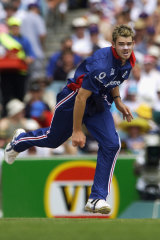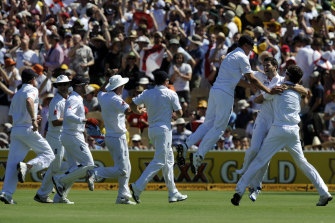Anderson v Australia: the making of ‘Grumpy Uncle Jimmy’
A couple of weeks before the last Ashes series in 2019, Barney Douglas’ film The Edge premiered in London. It chronicled the rise and fall of the first England team to make it to No.1 in the world.
As a piece of film, The Edge is among the best sporting documentaries ever made, spinning off a multitude of strong responses. For James Anderson, England’s greatest wicket-taker and the only member of the principal cast still playing, the reaction was singular.
English paceman James Anderson.Credit:Getty Images
“Watching this film made me realise how much I hate Australians,” he declared, tongue firmly-in-cheek, afterwards. “George Bailey smiling at me. Stop smiling at me mate, you’re rubbish!”
While Anderson was to have his 2019 series ruined by a calf injury that took him to the brink of retirement, the yearning to face Australia again was strong. And there is something deep down in Anderson that stirs those emotions, more so than just about any player on either side this series.
To get an idea of what it could be, it’s best to look back at his earliest days in international cricket. Anderson, you see, came through at a time when England were trying as hard as they ever have not only to beat Australia but to be like Australia, in every way. Seven consecutive Ashes series defeats had forced their hand.
At the end of his first season as a professional cricketer, Anderson and a fellow Lancastrian tearaway, Kyle Hogg, flew to Australia to be part of the intake of a new ECB cricket academy, to be run by none other than Rod Marsh. The academy was based Down Under because the English facilities were not ready.
Once in Adelaide at the Del Monte beach house that had hosted the likes of Ricky Ponting, Justin Langer and Damien Martyn, Anderson was schooled in Marsh’s aggressive view of the game – take it forward, score runs fast, field athletically, aim for wickets over containment.
At the same time, bowling coach Troy Cooley took Anderson’s instinctive action, with its high gather and trademark duck of the head at the point of delivery, and tried to turn it into a facsimile of Brett Lee’s. Anderson bears no ill will towards Cooley, who is back working with England. But take a look at footage of Anderson that summer and you will be surprised how strange it looks. Imagine how unnatural it felt.
Finally, after injuries dug deep into the England touring squad contesting the Ashes, Anderson was abruptly called into the senior group in Melbourne for the start of the one-day triangular series at the MCG in December 2002. His memories of those first exchanges, peering from the top of his mark to see Adam Gilchrist and Matthew Hayden glaring back at him, are still vivid.
Facing the likes of Adam Gilchrist and Matthew Hayden was an eye-opening experience for Anderson.Credit:Getty Images
“It was eye-opening, definitely,” Anderson tells The Age and The Sydney Morning Herald. “That was never the way I’d played cricket or seen cricket played either. It was this really super-confident way of like ‘We are so much better than you and we are going to absolutely destroy you, no matter how old you are, no matter how many games you’ve played’. It was this real domineering kind of feeling you’d get when you walked on the field.
“My first game bowling at Gilchrist and Hayden, where do you bowl at them? It was just such an eye-opening experience. But something that definitely held me in good stead. I think seeing that first-hand, seeing that cricket can be played completely differently to … I’d played a year of first-class cricket in England, which was quite gentle really, compared to going over to Australia, playing white-ball cricket at the MCG, bowling at Hayden and Gilchrist. It was quite a big mindset switch, so I think it did help me … eventually.”
Anderson impressed on that tour and at the World Cup immediately after it, but subsequent meetings with Australia left the distinct impression that the likes of Hayden (who mocked him with the epithet of “clubbie”), Ponting and Langer felt he could be “got at”. For a time, they were right, as Anderson wrestled with the action Cooley had tried to foist upon him.
“A guy like James Anderson, early in his career, we were able to keep down for long periods of time,” Ponting has said. “It’s not so much targeting guys, but they were younger players coming into international cricket and we knew if we could do that we might get the better of them.”
In 2009, Langer went as far as to put all this in print, in an email to the then Australian coach Tim Nielsen ahead of an Ashes series. As he explained in 2019: “If we get specific, I said in that email, which caused great headlines, that James Anderson was a pussy. Now that’s my way of just talking about his body language.
‘James Anderson has turned into a brilliant, great English fast bowler.’
“When we played against James Anderson as a young man, we felt that if we got on top of him, hit anything loose he bowled, his body language would drop a little bit. Do I think that now about James Anderson? Absolutely not, and I hope you write this in the article, James Anderson has turned into a brilliant, great English fast bowler.”
What Anderson became was a focused version of the young, angry quick bowler from Burnley. Returning to his natural bowling action and realising that his cruising speed, with control and movement of the ball, was more than quick enough to hurry batters, Anderson also brought an abrasive, verbally blunt persona to bear against Australia – almost like they were facing up against one of their own.
“I’ve always had the competitive edge that turns me into a different person when I get on the cricket field,” Anderson says. “Since I was even a young kid really, 12 or 13, I was desperate to win. Same with football, basketball or whatever sport I played as a kid, I just wanted to win and it just made me the guy you see on the field. I’m definitely very different off the field, but I think it just works for me.
“It’s the competitiveness, the wanting to win the battle that comes out. It was red mist as a kid when I started out, it was just blind anger, and over the years I’ve managed to control it for the most part, control it to an extent. Obviously there are times when I go a bit over and things get heated, but generally I’ve been able to mould it and use it to my advantage.”
Jimmy Anderson and his England teammates celebrated hard after he dismissed Ricky Ponting in Adelaide in 2010.Credit:Sebastian Costanzo
Almost universally, Australian players have not enjoyed it. Anderson has had a habit of picking pet names for various opposing players, some quite boorish in language, chipping away at them relentlessly. And in an era when post-play dressing-room drinks have been rare, that is all most Australian cricketers have known of him. Apart from those who played for Lancashire.
“I’ve played with some great guys over the years,” he says. “Fortunate enough at Lancs to play with Stuey Law, Andrew Symonds, Brad Hodge, Simon Katich, great guys who’ve done a lot for cricket in our county. Usman Khawaja as well played for Lancashire, and I’ve got on well with all of them.″
It’s only now, in his late career as the senior pro in the England attack and as “Grumpy Uncle Jimmy” on the wildly successful BBC Tailenders podcast, that Anderson has let some of that edge soften, and seen the value in removing the intimidatory masks of a few former opponents too.
“When you come up against Australia after seeing them on TV, you almost put them on a pedestal as these amazing players in the game,” he says. “But actually if you talk to them, they’re just really nice blokes. I’ve spoken to Gilly quite a lot, I’ve actually worked with Gilly a bit on commentary, and you couldn’t meet a nicer bloke.
“But I’ve had nightmares about bowling to him because he was just so intimidating to bowl at, and it’s not until you talk to him that you realise they’re just human beings. So the more cricket we’ve played, there’s so much franchise cricket going on around the world, so guys do know each other really well.
“Ben [Stokes] and Jos [Buttler] playing with Steve Smith at Rajasthan, the other teams in the IPL, they get to know each other really well. And when you know each other and become friends off the field, it’s very difficult to then not be friends on the field.”
There is, ultimately, something sad about playing 20 years of international cricket and having so few opponents know the person beyond the boundary. But in the story of Anderson there is an echo too of how many Australian cricketers of the same era are seen around the world.
And at 39, in reflective mode, Anderson even has a touch of empathy for the Australian teams that followed Ponting, Hayden, Gilchrist and company. It has been a lot of history for them to carry around, compelling a certain style of play that has not always been true to the players themselves.
‘We’ve never quite had that team to leave behind such a legacy of worldwide dominance in most forms of the game.’
“We’re fortunate in England that we’ve never quite had that team to leave behind such a legacy of worldwide dominance in most forms of the game,” he says. “Captains who’ve done great things must then put so much pressure on the incoming captain to live up to those standards, and the same with players.
“Australia play a certain way, that’s what everyone in the world thinks, they play this way in white-ball cricket, in red-ball cricket, this is the Australian way of playing. It must put pressure on guys to play that particular way, and maybe at times [it is] out of character for them.”
Sports news, results and expert commentary. Sign up for our Sport newsletter.
Most Viewed in Sport
From our partners
Source: Read Full Article



